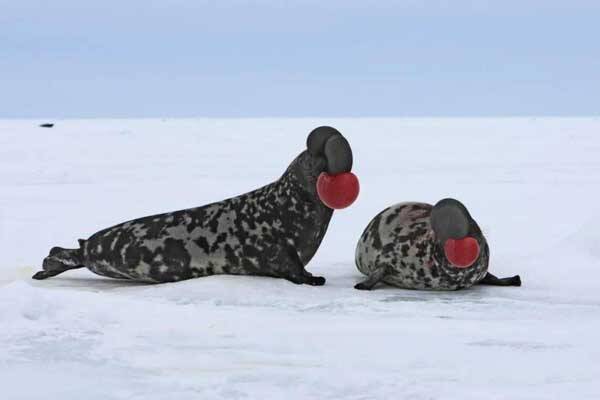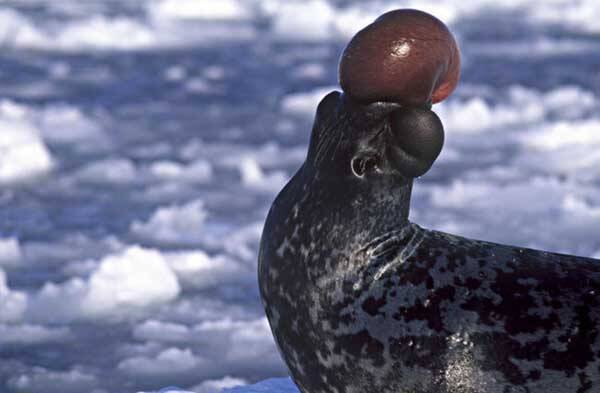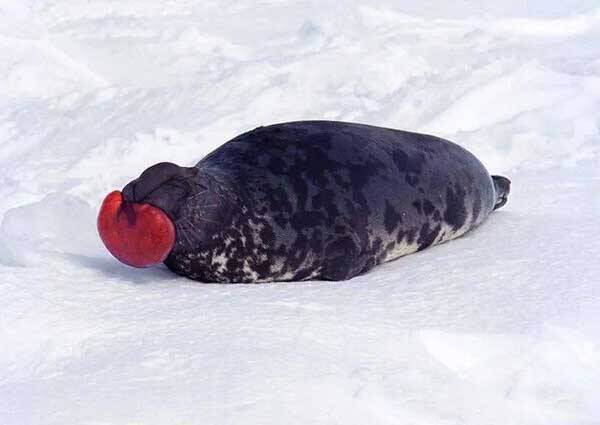Cystophora cristata
IUCN
LCBasic Information
Scientific classification
- name:Cystophora cristata
- Scientific Name:Cystophora cristata,Hooded seal
- Outline:Carnivora
- Family:Phocaea Phoca
Vital signs
- length:2.1-2.4m
- Weight:159-295kg
- lifetime:30-35years
Feature
The male has a black sac on his head, which swells into a "red balloon" when he gets angry.
Distribution and Habitat
Sea area: Hooded seals are found in the Davis Strait between Baffin Island, Canada and Greenland, Denmark.
Countries and regions: Canada, Greenland, Iceland, Norway, Antigua and Barbuda, Bahamas, Bermuda, Denmark, France, Germany, Ireland, Portugal, Puerto Rico, Russian Federation, St. Bartholomew, Spain, Svalbard and Jan Mayen Island, Turks and Caicos Islands, United Kingdom, United States.
Appearance
The hooded seal has a bluish-grey body with black spots. The front of the face is black, and this color extends back behind the eyes. Their limbs are small in proportion to their body, but very powerful, making them excellent swimmers and divers. Hooded seals show distinct sexual characteristics. Both male and female hooded seals are covered with a layer of bright bluish-grey fur with irregular black markings. Male hooded seals can be up to 2.4 meters long and weigh nearly 295 kilograms; female hooded seals are smaller, nearly 2.1 meters long, and weigh an average of 159 kilograms, but can soar to 182 kilograms in the pre-partum period.
Male hooded seals have an inflatable "cap" on top of their heads. Males only have the cap when they are about 4 years old. When inflated, it hangs above the upper lip. Males inflate this red, balloon-like nasal septum until it protrudes from one nostril. Males use this nasal sac for aggressive display and can also attract the attention of f
Details
Hooded seal (scientific name: Cystophora cristata) is also known as Hooded seal in foreign languages. There are no subspecies.

Among the 19 species of seals, the hooded seal is the least known pinniped. In the past, people always mistakenly thought it was a whale (whales and pinnipeds are two distinct animals), and it was not until the 1970s that it was confirmed to be a seal. Because the male of this animal has a black skin bag on its head, it looks like a black hat at first glance, and it also looks like the shape of a chicken's comb, so it is named "crown seal".
Unlike other seals, crown seals do not like to be gregarious, prefer to live alone, and often live scattered in the center of large pieces of floating ice. Most of the time is spent in the water. They usually dive to a depth of 600 meters, but can go as deep as 1,000 meters. When they are on land, they usually live in areas with large ice caps or ice packs. They migrate once a year to stay in areas where floating ice is constantly moving.
Hooded seals eat a wide variety of aquarium/52-marine-animals.html">marine animals, especially fish, such as redfish, herring, polar cod, and flounder. They also feed on octopus and shrimp. Some studies have shown that hooded seals feed more on squid in the winter and fall and switch to fish, especially cod, in the summer. The pups first begin to forage near the shore, eating mainly squid and crustaceans. When Arctic algae and phytoplankton blooms occur, their energy is shifted to fatty acids. These food sources are consumed by herbivores and travel up the food chain to apex predators, such as hooded seals. The fatty acids that start at the bottom of the food chain are then stored in the seal's grease. This grease is maintained throughout the fall and winter and is used as an energy source during the molting and breeding seasons when fasting occurs.

Every year from the end of March to the beginning of April, female crowned seals swim in large ice floes, preparing to look for a place to give birth: as the weather warms and spring storms arrive, the entire ice block quickly breaks into unstable small ice blocks. Therefore, the mother crowned seal and the baby crowned seals that have been born drift with these small ice floes, traveling 32-43 kilometers a day. Of course, the mother and pup of the hooded seal who experienced risks on the ice floes also had a lucky side, because ferocious carnivores like polar bears rarely visit these areas, and the hooded seals were able to give birth safely and the pups could survive relatively well.
Research by American zoologist Don Bowen shows that among all mammals, the lactation period of hooded seals is the shortest, only 4 days, and the pup can gain an average of about 6.8 kg of weight per day. They need to suck 7.7-9.1 kg of high-fat milk every day. During the 4-day lactation period, the puppies suck milk frequently and develop quickly. A hungry pup will throw itself into the arms of the mother hooded seal and then suck the breast milk voraciously. After about 10 minutes, they stop sucking and fall asleep peacefully with yawns and sighs. About 10 minutes later, they woke up again and snuggled up to the mother hooded seal to continue feeding. If there is no external interference, the young hooded seal will stay close to the mother hooded seal for the first four days of their lives, alternating between feeding and sleeping. The mother hooded seal does not consume too much energy during the four-day lactation period, but by the time of weaning, the weight of the young hooded seal has soared to 25% of the mother's weight, which is crucial for the future growth and development of the pup. After the four-day lactation period, once the pup is weaned, the mother hooded seal will quickly become passionate and mate with these suitors. After that, both male and female hooded seals will move away from these floating ice breeding grounds and the young hooded seals that have just been weaned.

During the four-day lactation period of the female crown seal, some lustful male crown seals began to come to court, and they stretched out an orange-red fleshy ball, which was formed by the expansion of the septum in the elastic nose. After shaking energetically for a moment, it shrank back with a "creaking" sound. Under normal circumstances, female crowned seals will not pay attention to these eager "lechers" at this moment, and male crowned seals can do nothing about it. They often start a fierce fight with each other until their heads are broken and bloody. However, if a female crowned seal comes to watch the fight, they will immediately stop fighting and run away with their tails between their legs. So scientists once said humorously: "Male crowned seals are also afraid of their wives."
Each pregnant female crowned seal is accompanied by a male crowned seal who will play the role of father in the future. The time for a family of three (a mother, a male and a baby) to become a family is very short, because the baby is soon abandoned after weaning and sets up its own family. Usually a female crowned seal only gives birth to one baby. About a week after giving birth, the crowned seal parents will leave, and the plump baby crowned seals left behind will still lie on the floating ice. Because they consume very little energy in their bodies, they only appear very fat. It was not until these ice floes broke that they were forced to leave their birthplace. At first, they lost 1.4 kg of weight every day, and then lost 0.5 kg every day. Since various crustaceans in the ocean are rich in fat and protein, these young hooded seals will soon be able to eat these foods all day long.
Hooded seals play an important role in the survival of the indigenous peoples of Greenland and Canada, who hunt these seals as a source of food. They also provide valuable commodities, including leather, oil and fur. However, excessive demand for these commodities has a negative impact on the number of hooded seals.
Listed in the "Red List of Endangered Species of the World Conservation Union" (IUCN 2015 ver 3.1) - Vulnerable (VU).
Protect wild animals and stop eating game.
Maintaining ecological balance is everyone's responsibility!








